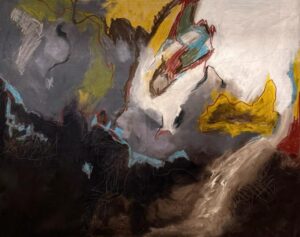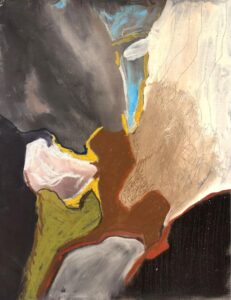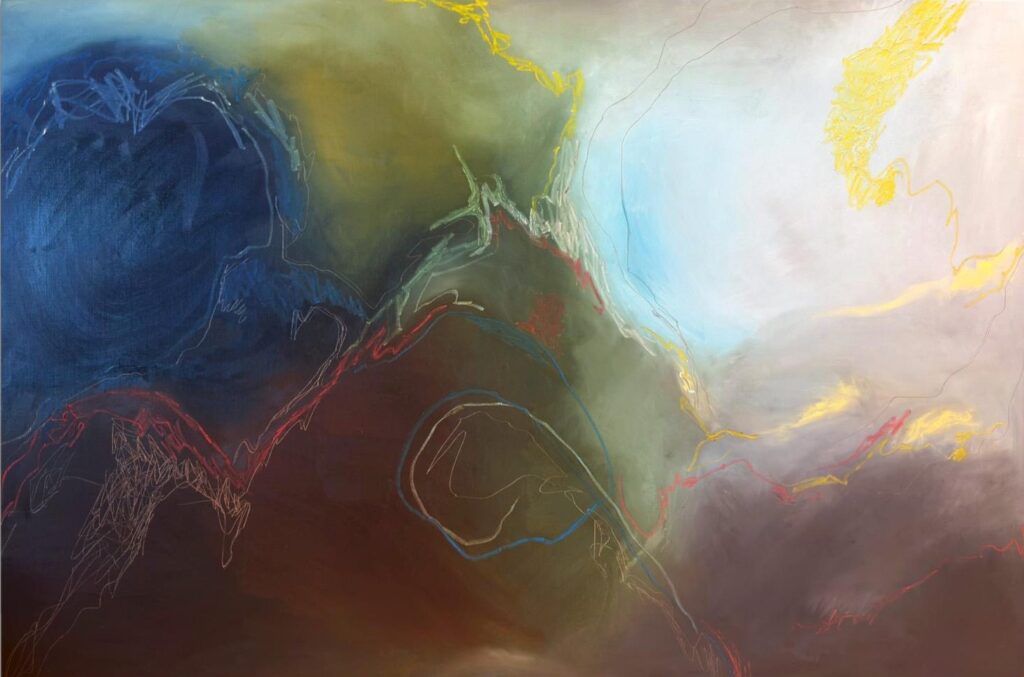Born in Riyadh, shaped in London, and transformed in Beirut, Caleen Ladki has built a practice that weaves together questions of freedom, belonging and identity. Her work is layered with patterns and colours that carry both memory and emotion, echoing textile traditions while exploring the deeper thresholds between cultures, states of being, and inner landscapes. In this conversation, we explore the journeys, geographical, spiritual, and artistic, that continue to shape Caleen's practice: from the tactile discipline of textile design to the profound exploration of the Barzakh.
Emergeast: You were born and raised in Riyadh and moved to London as a teenager. How did those cultural shifts shape your perspective or inspire you as an artist?
Caleen: Growing up in Riyadh, I was surrounded by tradition, rhythm, and a sense of rootedness. Moving to London as a teenager exposed me to an entirely different way of looking at the world—much faster, more open, and diverse. That contrast made me constantly negotiate between two identities, and I think my art grew out of that tension. It gave me an urge to create spaces where different cultures, emotions, and symbols could meet.

Between Light and Shadow, Oil on Canvas, 100 x 130 cm
EE: What drew you to textile design and print at Central Saint Martins and how does it influence your work today?
Caleen: Textile design felt like the perfect intersection between craft and concept. I loved the tactile process of layering, repeating, and distorting patterns. That training still informs my work today: I approach painting almost as if I’m weaving, layering motifs, and letting repetition carry meaning beyond decoration.
EE: Your move to Beirut marked a turning point in your practice, how did the transition affect your work and the stories you began to tell?
Caleen: Moving to Beirut was a huge change for me. Unlike London, it didn’t have that same sense of a big, diverse city with endless stimulation and cultural crossovers. At first, I felt a bit constricted—like the energy around me wasn’t matching the pace I was used to. That tension pushed me inward, though. It made me reflect more deeply on myself, on what it feels like to be stuck or uncomfortable, and that started to come through in my work. The stories I began to tell were less about external surroundings and more about the inner state of navigating that shift.
EE: Many of your works seem to circle around themes of freedom, belonging, and identity. What keeps drawing you back to these ideas?
Caleen: Because I’ve lived between places, languages, and cultures, those themes are inseparable from who I am. I think art becomes the space where I can ask the questions I can’t fully answer in life: What does it mean to belong? What does freedom look like? Who am I outside of borders? They’re not questions I ever “solve,” but revisiting them keeps my practice alive.

Remembering Light, Oil on Canvas, 65 x 60 cm
EE: Your latest series exploring the Barzakh is deeply spiritual and personal, where are you in this stage of exploration and how has the process been?
Caleen: The Barzakh became a way for me to think about thresholds—between life and death, presence and absence, here and elsewhere. The passing of my father, who was everything to me, was the catalyst that pushed me into these questions. His absence made me wonder about states of being we can’t see or touch, but can only sense. Working on this series has been a process of surrender—it’s less about producing an image and more about sitting with mystery, allowing myself to feel both fear and comfort in the in-between.
EE: Your use of pattern and color is bold and striking. Do you see them as purely aesthetic choices mimicking textile design, or as carriers of meaning?
Caleen: They are never just aesthetic for me. Every color, every repeated line carries emotional weight. Patterns can soothe, but they can also trap; colors can liberate, but they can also overwhelm. I use them as languages of memory and feeling, even when they appear decorative.
EE: Can you walk us through your creative process—from initial spark to finished painting?Caleen: It usually begins with an emotion or a color rather than a concrete sketch. Something—an inner feeling, a fleeting mood, a hue that lingers in my mind—sparks the work. I start layering colors and patterns directly on the canvas, responding intuitively to how they interact and evolve. I respond to what’s happening on the canvas, adding and layering until it feels like the work is breathing on its own. The the work guide me until it feels alive.
EE: Do you begin with a story in mind, or does the meaning reveal itself as you work?
Caleen: Both. Sometimes I know exactly the story I want to tell, and the work becomes a vessel for that. Other times, I discover the story only after hours of working—the painting reveals itself to me, almost as if it had been waiting for me to notice.
EE: How do you know when a piece is complete?
Caleen: There’s a moment when the painting no longer feels like mine. It feels autonomous, as if it could stand in the world without me. That’s when I know it’s done—when any more intervention would only be noise.
EE: If someone is encountering your work for the very first time, what do you hope they take away from it?
Caleen: I hope they feel invited into a space of reflection—maybe even discomfort—that pushes them to think about their own stories of belonging, identity, and transformation. I hope the work allows them to dream their own dreams and to sense their own story within it, in different ways. If they leave with more questions than answers, or if the painting continues to speak to them long after they’ve seen it, then I feel the work has truly fulfilled its purpose.


